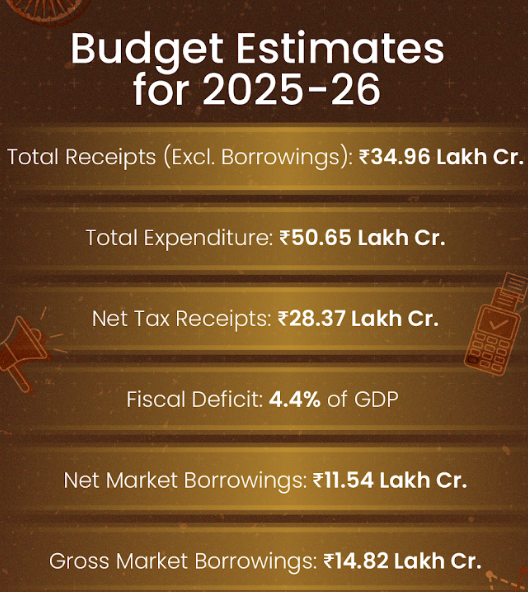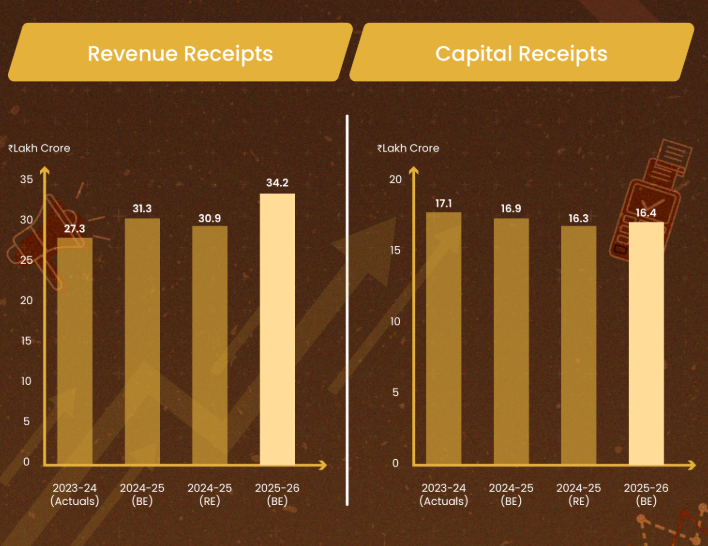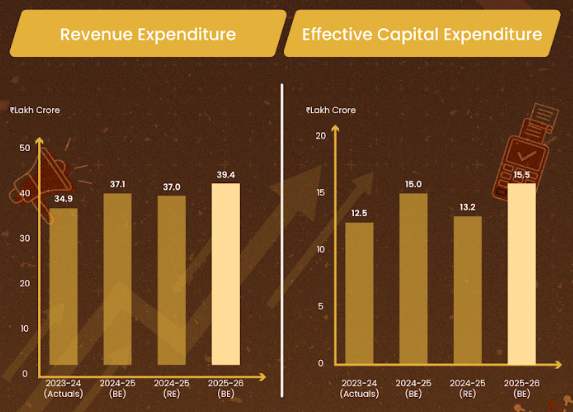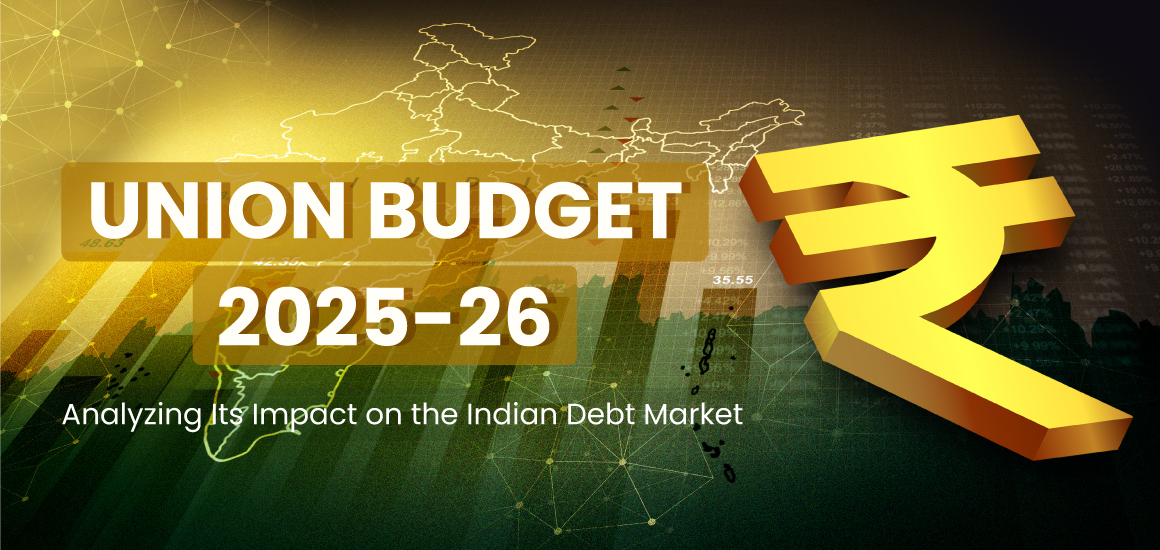Introduction: The Budget’s Role in the Debt Market
The Union Budget plays a pivotal role in shaping India’s financial landscape, particularly the debt market, by outlining government spending, borrowing plans, and fiscal strategies. It directly influences bond yields, investor sentiment, and liquidity conditions, making it a key event for market participants, including institutional and retail investors.
Budget 2025-26 in the Context of Global Trends
The 2025-26 Budget comes at a crucial time as global financial conditions evolve. With US Treasury yields stabilizing around 4.2%, India’s government bonds could attract Foreign Portfolio Investors (FPIs) seeking higher yields. Additionally, inflation trends and geopolitical uncertainties are shaping investor preferences, making India’s fiscal discipline a key driver of market confidence.
By setting a clear roadmap for debt management, fiscal consolidation, and infrastructure financing, Budget 2025-26 is expected to create opportunities for both domestic and international investors in the Indian debt market.
Key Announcements Affecting the Debt Market in Union Budget 2025-26
Fiscal Deficit Target: A Push for Fiscal Consolidation
The government has set the fiscal deficit target for FY 2025-26 at 4.4% of GDP, down from 4.8% in FY 2024-25. This move reinforces India’s commitment to fiscal prudence and economic stability.
- A lower fiscal deficit suggests that the government is borrowing less to fund its expenses, which could ease pressure on bond yields and reduce borrowing costs in the long run.
- A tighter fiscal stance also enhances India’s creditworthiness, potentially making Indian bonds more attractive to Foreign Portfolio Investors (FPIs).
Impact on Debt Market: Fiscal consolidation signals reduced government debt supply, potentially lowering bond yields and improving liquidity in corporate and infrastructure bonds.

Government Borrowing Plans: Managing Market Supply
The government has outlined net market borrowings of ₹11.54 lakh crore from dated securities and gross borrowings of ₹14.82 lakh crore, slightly lower than last year’s ₹15.43 lakh crore.
- Lower borrowing = Less bond supply → This could help stabilize long-term bond yields, making them more attractive for investors.
- Higher FPI participation expected as government securities become more appealing amid stable interest rates.
Impact on Debt Market: A well-managed borrowing program could moderate bond yield volatility, ensuring steady demand for government and corporate bonds.
Taxation & Investment Reforms: Boosting Fixed-Income Appeal
While no major changes were made in capital gains taxation for debt instruments, the government has indicated possible future relaxations in TDS (Tax Deducted at Source) on bond investments to encourage retail participation.
- A friendlier tax regime for bonds could increase retail investor participation, deepening the debt market.
- Reduction in TDS could also improve liquidity in corporate bonds and NCDs (Non-Convertible Debentures), making them more attractive.
Impact on Debt Market: If executed, these changes would broaden the investor base for bonds, reducing dependence on institutional investors.
Infrastructure & Green Bonds: Expanding Sustainable Financing
The government has allocated ₹11.11 lakh crore for capital expenditure, a 10% YoY increase, with a portion of funding to be raised via bonds.
Green Bonds & Municipal Bonds:
- Expansion of green bonds and municipal bonds will help fund long-term sustainable and infrastructure projects.
- These instruments could attract ESG-focused investors, further deepening India’s bond market.
Impact on Debt Market: The push for green financing and higher infra spending will increase bond supply, but could also create new investment opportunities for institutional and global investors.
Monetary Policy & Inflation Management: Setting the Stage for Rate Cuts
The RBI’s monetary stance will play a crucial role in shaping bond market trends in 2025.
- With inflation under control, the RBI is expected to cut interest rates later in 2025, which could drive bond prices higher and lower yields.
- Liquidity measures, including Open Market Operations (OMO) and Variable Rate Repos (VRR), will help maintain stability in the debt market.
Impact on Debt Market: Lower interest rates will reduce borrowing costs, encourage corporate bond issuance, and increase fixed-income investments.
How These Announcements Shape the Debt Market
The Union Budget 2025-26 presents a balanced approach—fiscal consolidation, moderate borrowing, tax incentives, and green financing, all of which shape bond yields, liquidity, and investor participation.
Key Takeaways for Debt Market Participants
- Lower fiscal deficit = Improved bond market stability
- Managed government borrowing = Lower yield volatility
- Potential tax relaxations = Higher retail bond participation
- Increased green bond issuance = New ESG investment opportunities
- Expected RBI rate cuts = Favorable bond market outlook
As India strengthens its fixed-income market, this budget sets the tone for sustainable investment growth, ensuring stability and attractive returns for bond investors in 2025 and beyond.
How Will This Impact the Indian Debt Market?
Bond Yields & Investor Sentiment: A Positive Outlook
Bond yields play a critical role in the debt market, affecting the attractiveness of government and corporate securities.
Lower Fiscal Deficit = Reduced Bond Supply = Softer Yields
- The government’s borrowing plan for FY26 is estimated at ₹11.54 lakh crore (net) and ₹14.82 lakh crore (gross), slightly lower than last year.
- A lower borrowing requirement suggests reduced supply of government securities (G-secs), which could push bond yields lower due to higher demand for limited bonds.
- The 10-year G-sec yield, which stood at around 7.1% in early 2024, may see further softening if borrowing remains controlled.
Impact on Debt Market
- Lower yields reduce the government’s borrowing costs, improving fiscal sustainability.
- Increased demand from investors looking for stable, lower-risk investments.
- Favorable conditions for corporate bonds, as investors may shift from sovereign debt to higher-yielding corporate papers.
Foreign Portfolio Investments (FPIs): A Game-Changer for Indian Bonds
Foreign investors closely watch India’s fiscal and interest rate trends when allocating capital. The budget’s focus on fiscal prudence and the potential for interest rate cuts could make Indian debt more attractive globally.
Global Debt Trends & FPI Inflows
- The US 10-year Treasury yield remains a benchmark for global investors. In 2024, it ranged between 4.5-5%, limiting FPI inflows into India.
- However, if the US Federal Reserve cuts rates in 2025, it could boost FPI participation in Indian debt markets, as Indian bonds offer better real returns.
Potential Inclusion of Indian G-secs in Global Bond Indices
- Discussions continue around including Indian G-secs in JP Morgan & Bloomberg Global Bond Indices.
- If implemented, this could attract $25-30 billion in FPI flows into Indian bonds.
Impact on Debt Market:
- Higher FPI inflows could boost demand for Indian bonds, stabilizing yields.
- A wider investor base would improve liquidity and lower volatility in the bond market.
- Strengthened rupee stability, as higher FPI inflows reduce currency pressures.

Corporate Bond Market: A Big Boost for Infra & Private Debt
A well-functioning corporate bond market is essential for long-term economic growth. With lower government borrowing, there is greater liquidity available for corporate issuances.
Infrastructure Spending = Increased Corporate Bond Issuances
- The government has raised capital expenditure to ₹11.11 lakh crore, a 10% YoY increase, focusing on highways, railways, and energy projects.
- This increased spending will spur bond issuances from infrastructure companies, which could tap into debt markets for financing.
More Corporate Bonds, Lower Borrowing Costs
- With less crowding out by government securities, corporate borrowers—especially AAA & AA-rated firms—may find it cheaper to raise debt.
- Private sector bond issuances could increase liquidity and diversity in fixed-income instruments.
Impact on Debt Market:
- Diversified debt market, with infrastructure & corporate bonds gaining traction.
- Better financing conditions for businesses, enabling expansion and job creation.
- Higher retail investor participation as companies issue bonds at attractive yields.

Challenges & Risks to Watch Out For in the Indian Debt Market
While the Union Budget 2025-26 lays the groundwork for fiscal discipline and sustainable borrowing, several challenges and risks could impact the Indian debt market. Global economic conditions, government borrowing trends, and RBI’s liquidity management will be key factors shaping the outlook for bond yields, investor sentiment, and market stability.
Market Volatility from Global Factors: The Fed Effect
India’s debt market is highly sensitive to global economic movements, particularly US Federal Reserve (Fed) rate decisions.
- In 2024, the US Fed maintained interest rates in the range of 5.25% – 5.50%, which impacted global bond markets by keeping yields high.
- If the Fed begins rate cuts in 2025, this could increase capital flows into emerging markets like India, boosting foreign portfolio investment (FPI) in Indian bonds.
- However, if US inflation remains sticky and the Fed delays rate cuts, US Treasury yields could stay elevated, reducing the appeal of Indian bonds for global investors.
Potential Risks for the Indian Debt Market:
- Delayed Fed rate cuts may keep FPI inflows subdued, affecting rupee stability and bond demand.
- High US bond yields may compete with Indian bonds, making them less attractive to foreign investors.
- Geopolitical tensions or commodity price shocks (like rising oil prices) could increase global risk aversion, causing volatility in debt markets.
Government Borrowing & Rising Bond Yields: A Delicate Balance
While the budget has set a fiscal deficit target of 4.4% for FY26 (down from 4.8% in FY25), higher-than-expected government borrowing could still push bond yields higher instead of lower.
Key Borrowing Figures from Budget 2025-26:
- Net market borrowings: ₹11.54 lakh crore
- Gross borrowings: ₹14.82 lakh crore
What This Means for the Debt Market:
Lower-than-expected borrowing signals fiscal consolidation and can reduce bond yields, making debt more affordable.However, if government borrowing increases beyond budget estimates, the excess supply of bonds could push yields higher, increasing borrowing costs for both government and corporates.If inflation remains above RBI’s target (4% ± 2%), investors may demand a higher risk premium, further increasing bond yields.
Historical Context:
In 2022, India’s 10-year G-sec yield rose above 7.4% due to higher-than-expected government borrowing and global tightening. If similar fiscal slippages occur, bond yields in 2025 could rise instead of falling, impacting government finances and corporate debt issuers.
RBI’s Liquidity Management: Ensuring Stability
The Reserve Bank of India (RBI) plays a crucial role in ensuring smooth debt absorption by managing liquidity in the banking system.
Budget 2025-26 is introducing several liquidity measures:
- Open Market Operations (OMOs): ₹60,000 crore bond purchases to inject liquidity.
- Variable Rate Repo (VRR): ₹50,000 crore to ensure banks have sufficient funds for lending.
- USD/INR Forex Swap Auction: USD 5 billion to manage currency volatility.
Challenges for RBI’s Liquidity Management:
- If liquidity tightening occurs, banks may face higher funding costs, limiting their ability to buy government bonds.
- Inflation concerns could limit RBI’s ability to inject liquidity, which may restrict credit availability and economic growth.
- Uncertainty in global financial flows (due to geopolitical risks, Fed policies, or oil price shocks) may make liquidity management more complex.
Past Trends:
In 2018, when RBI withdrew excess liquidity aggressively, bond yields spiked above 8%, impacting government borrowing and corporate lending. A similar situation in 2025 could disrupt the debt market’s stability.
Final Takeaway: Navigating Uncertainties
While the Union Budget 2025-26 provides a roadmap for fiscal prudence, several external and domestic risks could impact the debt market:
- Fed rate decisions and US bond yields will determine foreign investor sentiment.
- Unexpectedly high government borrowing could push bond yields up.
- RBI’s liquidity management will be crucial in ensuring smooth debt absorption and market stability.
What to Watch for in 2025:
Government’s actual borrowing vs. budget estimates – A deviation could impact bond yields.
RBI’s interest rate decisions and liquidity measures – A rate cut could boost demand for bonds.
Global economic trends, especially US Fed rate cuts – Higher FPI inflows could stabilize yields.
For investors, staying informed and actively managing fixed-income portfolios will be key to navigating the evolving landscape of India’s debt market in 2025.
Conclusion: What Investors Should Expect from Budget 2025-26
The Union Budget 2025-26 reinforces a commitment to fiscal discipline, with a fiscal deficit target of 4.4% of GDP, down from 4.8% in FY25. This controlled borrowing approach could lead to lower bond yields, making government securities (G-secs), corporate bonds, and green bonds attractive investment opportunities.
Key Takeaways for Investors
- Government Bonds (G-Secs): With fiscal consolidation in focus, 10-year G-sec yields may soften, creating opportunities for long-term investors.
- Corporate Bonds: Lower government borrowing could free up liquidity for corporates, leading to increased bond issuances in infrastructure, renewable energy, and manufacturing.
- Green Bonds: The government’s push for sustainable development, reflected in an ₹11.11 lakh crore capital expenditure, signals growth in green and municipal bonds, making them attractive for ESG-focused investors.
Interest Rate & Inflation Outlook
- The RBI is expected to cut rates in 2025, further supporting bond investments.
- Inflation control measures outlined in the Budget will play a key role in determining the trajectory of bond yields.
Call to Action for Investors
- Stay updated on bond market trends post-Budget to seize emerging opportunities.
- Explore fixed-income investments aligned with evolving fiscal policies to optimize returns.
As fiscal stability strengthens, fixed-income investors should closely monitor RBI rate decisions, global economic trends, and sectoral bond issuances for a well-balanced portfolio in 2025.







2 comments
[…] Union Budget 2025-26: Impact on Indian Debt Market […]
[…] policy decisions made in the Union Budget will also directly impact household consumption, corporate investments, and investor […]
Comments are closed.